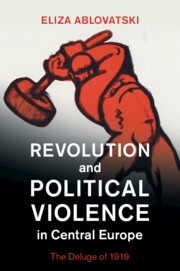19 results
1 - Central European Roots of Revolution
-
- Book:
- Revolution and Political Violence in Central Europe
- Published online:
- 18 June 2021
- Print publication:
- 01 July 2021, pp 19-42
-
- Chapter
- Export citation
Index
-
- Book:
- Revolution and Political Violence in Central Europe
- Published online:
- 18 June 2021
- Print publication:
- 01 July 2021, pp 299-302
-
- Chapter
- Export citation
Conclusion
-
- Book:
- Revolution and Political Violence in Central Europe
- Published online:
- 18 June 2021
- Print publication:
- 01 July 2021, pp 251-260
-
- Chapter
- Export citation
Copyright page
-
- Book:
- Revolution and Political Violence in Central Europe
- Published online:
- 18 June 2021
- Print publication:
- 01 July 2021, pp iv-iv
-
- Chapter
- Export citation
4 - Revolution on Trial
-
- Book:
- Revolution and Political Violence in Central Europe
- Published online:
- 18 June 2021
- Print publication:
- 01 July 2021, pp 120-165
-
- Chapter
- Export citation
Figures
-
- Book:
- Revolution and Political Violence in Central Europe
- Published online:
- 18 June 2021
- Print publication:
- 01 July 2021, pp ix-ix
-
- Chapter
- Export citation
6 - Remembering the World Revolution
-
- Book:
- Revolution and Political Violence in Central Europe
- Published online:
- 18 June 2021
- Print publication:
- 01 July 2021, pp 206-250
-
- Chapter
- Export citation
Dedication
-
- Book:
- Revolution and Political Violence in Central Europe
- Published online:
- 18 June 2021
- Print publication:
- 01 July 2021, pp v-vi
-
- Chapter
- Export citation
5 - Seeing Red
-
- Book:
- Revolution and Political Violence in Central Europe
- Published online:
- 18 June 2021
- Print publication:
- 01 July 2021, pp 166-205
-
- Chapter
- Export citation
Acknowledgments
-
- Book:
- Revolution and Political Violence in Central Europe
- Published online:
- 18 June 2021
- Print publication:
- 01 July 2021, pp x-xii
-
- Chapter
- Export citation
Introduction
-
- Book:
- Revolution and Political Violence in Central Europe
- Published online:
- 18 June 2021
- Print publication:
- 01 July 2021, pp 1-18
-
- Chapter
- Export citation
2 - World War and World Revolution
-
- Book:
- Revolution and Political Violence in Central Europe
- Published online:
- 18 June 2021
- Print publication:
- 01 July 2021, pp 43-78
-
- Chapter
- Export citation
Bibliography
-
- Book:
- Revolution and Political Violence in Central Europe
- Published online:
- 18 June 2021
- Print publication:
- 01 July 2021, pp 261-298
-
- Chapter
- Export citation
Tables
-
- Book:
- Revolution and Political Violence in Central Europe
- Published online:
- 18 June 2021
- Print publication:
- 01 July 2021, pp viii-viii
-
- Chapter
- Export citation
3 - Rumor and Terror
-
- Book:
- Revolution and Political Violence in Central Europe
- Published online:
- 18 June 2021
- Print publication:
- 01 July 2021, pp 79-119
-
- Chapter
- Export citation
Contents
-
- Book:
- Revolution and Political Violence in Central Europe
- Published online:
- 18 June 2021
- Print publication:
- 01 July 2021, pp vii-vii
-
- Chapter
- Export citation

Revolution and Political Violence in Central Europe
- The Deluge of 1919
-
- Published online:
- 18 June 2021
- Print publication:
- 01 July 2021
Paul Lendvai. One Day That Shook the Communist World: The 1956 Hungarian Uprising and Its Legacy. Princeton: Princeton University Press, 2008. Pp. 249, illus.
-
- Journal:
- Austrian History Yearbook / Volume 40 / April 2009
- Published online by Cambridge University Press:
- 16 April 2009, pp. 357-359
- Print publication:
- April 2009
-
- Article
- Export citation
Erich Lessing. Revolution in Hungary: The 1956 Budapest Uprising. London: Thames & Hudson, 2006. Pp. 249, illus.
-
- Journal:
- Austrian History Yearbook / Volume 39 / April 2008
- Published online by Cambridge University Press:
- 28 April 2009, pp. 226-227
- Print publication:
- April 2008
-
- Article
- Export citation



